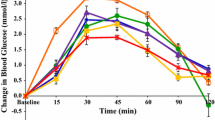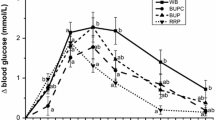Abstract
Purpose
To evaluate whether the modification of ingredients of two bakery products, muffins and bread, reduces their glycemic index, by means of in vitro and in vivo procedures.
Methods
In vitro and in vivo glycemic index were evaluated for two types of bread and two types of muffins including one standard product for each category. For the in vitro determination, kinetics of starch digestion method was used. For the in vivo procedure, postprandial glucose measured as IAUC was obtained in a group of eighteen healthy volunteers (ten did the test with muffins and eight with breads).
Results
In in vitro, a reduction in the expected glycemic index regarding the control muffin was achieved with the partial substitution of wheat flour by a mixture of resistant starch, dextrin and lentil flour. In breads, with the partial substitution of wheat flour by a mixture of resistant starch and dextrins, a decrease in the expected glycemic index was also observed. In in vivo, a reduction in GI was also achieved both in muffin and in bread. All the obtained GI was higher in in vitro method.
Conclusions
Despite the fact that in vitro overestimate in vivo method, the trend in the reduction in GI seems to be similar in both methods. With the substitution assayed, a reduction in the expected glycemic index and the glycemic index were obtained both in muffins and in breads.


Similar content being viewed by others
Change history
20 February 2021
A Correction to this paper has been published: https://doi.org/10.1007/s00394-021-02496-1
References
Probst-Hensch NM (2010) Chronic age-related diseases share risk factors: do they share pathophysiological mechanisms and why does that matter? Swiss Med Wkly 140:w13072
Jenkins DJ, Wolever TM, Taylor RH, Barker H, Fielden H, Baldwin JM et al (1981) Glycemic index of foods: a physiological basis for carbohydrate exchange. Am J Clin Nutr 34(3):362–366
Bjorck I, Liljeberg H, Ostman E (2000) Low glycaemic-index foods. Br J Nutr 83(Suppl 1):S149–S155
Augustin LS, Franceschi S, Jenkins DJ, Kendall CW, La Vecchia C (2002) Glycemic index in chronic disease: a review. Eur J Clin Nutr 56(11):1049–1071
Brand-Miller JC (2004) Postprandial glycemia, glycemic index, and the prevention of type 2 diabetes. Am J Clin Nutr 80(2):243–244
Schulze MB, Liu S, Rimm EB, Manson JE, Willett WC, Hu FB (2004) Glycemic index, glycemic load, and dietary fiber intake and incidence of type 2 diabetes in younger and middle-aged women. Am J Clin Nutr 80(2):348–356
Liu S, Willett WC, Stampfer MJ, Hu FB, Franz M, Sampson L et al (2000) A prospective study of dietary glycemic load, carbohydrate intake, and risk of coronary heart disease in US women. Am J Clin Nutr 71(6):1455–1461
Augustin LS, Dal Maso L, La Vecchia C, Parpinel M, Negri E, Vaccarella S et al (2001) Dietary glycemic index and glycemic load, and breast cancer risk: a case-control study. Ann Oncol 12(11):1533–1538
Franceschi S, Dal Maso L, Augustin L, Negri E, Parpinel M, Boyle P et al (2001) Dietary glycemic load and colorectal cancer risk. Ann Oncol 12(2):173–178
Monro JA, Mishra S (2010) Database values for food-based dietary control of glycaemia. J Food Compos Anal 23:406–410
Woolnough J, Monro J, Brennan C, Bird A (2008) Simulating human carbohydrate digestion in vitro: a review of methods and the need for standardization. Int J Food Sci Technol 43:2245–2256
Brand-Miller J, Holt S (2004) Testing the glycaemic index of foods: in vivo, not in vitro. Eur J Clin Nutr 58(4):700–701
Brouns F, Bjorck I, Frayn KN, Gibbs AL, Lang V, Slama G et al (2005) Glycaemic index methodology. Nutr Res Rev 18(1):145–171
Fardet A, Leenhardt F, Lioger D, Scalbert A, Remesy C (2006) Parameters controlling the glycaemic response to breads. Nutr Res Rev 19(1):18–25
Akerberg A, Liljeberg H, Bjorck I (1998) Effects of amylose/amylopectin ratio and baking conditions on resistant starch formation and glycaemic indices. J Cereal Sci 28(1):71–80
Angioloni A, Collar C (2010) Physicochemical and nutritional properties of reduced-caloric density high-fibre breads. LWT-Food Sci Technol 44(3):747–758
Fuentes-Zaragoza E, Riquelme-Navarrete MJ, Sánchez-Zapata E, Pérez-Álvarez JA (2010) Resistant starch as functional ingredient: a review. Food Res Int 43(4):931–942
Baixauli R, Salvador A, Martínez-Cervera S, Fiszman SM (2008) Distinctive sensory features introduced by resistant starch in baked products. LWT-Food Sci Technol 41(10):1927–1933
Sanz T, Salvador A, Baixauli R, Fiszman SM (2009) Evaluation of four types of resistant starch in muffins. II. Effects in texture, colour and consumer response. Eur Food Res Technol 229(2):197–204
Tharanathan RN, Mahadevamma S (2003) Grain legumes—a boon to human nutrition. Trends Food Sci Technol 14(12):507–518
Chung HJ, Liu Q, Hoover R, Warkentin TD, Vandenberg B (2008) In vitro starch digestibility, expected glycemic index, and thermal and pasting properties of flours from pea, lentil and chickpea cultivars. Food Chem 111(2):316–321
Goñi I, Garcia-Alonso A, Saura-Calixto F (1997) A starch hydrolysis procedure to estimate glycemic index. Nutr Res 17(3):427–437
Sanchez-Pardo ME, Ortiz-Moreno A, Mora-Escobedo R, Necoechea-Mondragon H (2007) In vitro starch digestibility and predicted glycemic index of microwaved and conventionally baked pound cake. Plant Foods Hum Nutr 62(3):99–105
Granfeldt Y (1994) Foods factors affecting metabolic responses to cereal products. University of Lund, Lund
Standardization IOf (2008) Food products-Determination of the glycemic index (GI) and relevant classification. International Organization for Standardization, Geneva
Brand-Miller JC, Stockmann K, Atkinson F, Petocz P, Denyer G (2009) Glycemic index, postprandial glycemia, and the shape of the curve in healthy subjects: analysis of a database of more than 1,000 foods. Am J Clin Nutr 89(1):97–105
Wolever TM, Vorster HH, Bjorck I, Brand-Miller J, Brighenti F, Mann JI et al (2003) Determination of the glycaemic index of foods: interlaboratory study. Eur J Clin Nutr 57(3):475–482
Tovar J, Sayago-Ayerdi SG, Penalver C, Paredes-Lopez O, Bello-Perez LA (2003) In vitro starch hydrolysis index and predicted glycemic index of corn tortilla, black beans (Phaseolus vulgaris L.), and Mexican “taco”. Cereal Chem 80(5):533–535
Behall KM, Scholfield DJ (2005) Food amylose content affects postprandial glucose and insulin responses. Cereal Chem 82(6):654–659
Cavallero A, Empilli S, Brighenti F, Stanca AM (2002) High (1 -> 3, 1 -> 4)-beta-glucan barley fractions in bread making and their effects on human glycemic response. J Cereal Sci 36(1):59–66
El SN (1999) Determination of glycemic index for some breads. Food Chem 67:67–69
Marques C, D’Auria L, Cani PD, Baccelli C, Rozenberg R, Ruibal-Mendieta NL et al (2007) Comparison of glycemic index of spelt and wheat bread in human volunteers. Food Chem 100(3):1265–1271
Germaine KA, Samman S, Fryirs CG, Griffiths PJ, Johnson SK, Quail KJ (2008) Comparison of in vitro starch digestibility methods for predicting the glycemic index of grain foods. J Sci Food Agric 88(4):652–658
Utrilla-Coello RG, Osorio-Díaz P, Bello-Pérez LA (2007) Alternative use of chickpea flour in breadmaking: chemical composition and starch digestibility of bread. Food Sci Technol Int 13(4):323–327
Foster-Powell K, Holt SH, Brand-Miller JC (2002) International table of glycemic index, glycemic load values. Am J Clin Nutr 76(1):5–56
Yamada Y, Hosoya S, Nishimura S, Tanaka T, Kajimoto Y, Nishimura A et al (2005) Effect of bread containing resistant starch on postprandial blood glucose levels in humans. Biosci Biotechnol Biochem 69(3):559–566
Goni I, Valentin-Gamazo C (2003) Chickpea flour ingredient slows glycemic response to pasta in healthy volunteers. Food Chem 81(4):511–515
Rosin PM, Lajolo FM, Menezes EW (2002) Measurement and characterization of dietary starch. J Food Compos Anal 15:367–377
Zabidi MA, Aziz NAA (2009) ) In vitro starch hydrolysis and estimated glycaemic index of bread substituted with different percentage of chempedak (Artocarpus integer) seed flour. Food Chem 117(1):64–68
Udani JK, Singh BB, Barrett ML, Preuss HG (2009) Lowering the glycemic index of white bread using a white bean extract. Nutr J 8:52
Vega-Lopez S, Ausman LM, Griffith JL, Lichtenstein AH (2007) Interindividual variability and intra-individual reproducibility of glycemic index values for commercial white bread. Diabetes Care 30(6):1412–1417
Englyst KN, Englyst HN, Hudson GJ, Cole TJ, Cummings JH (1999) Rapidly available glucose in foods: an in vitro measurement that reflects the glycemic response. Am J Clin Nutr 69(3):448–454
Chen YJ, Sun FH, Wong SH, Huang YJ (2010) Glycemic index and glycemic load of selected Chinese traditional foods. World J Gastroenterol 16(12):1512–1517
Campbell JE, Glowczewski T, Wolever TM (2003) Controlling subjects′prior diet and activities does not reduce within-subject variation of postprandial glycemic responses to foods. Nutr Res 23:621–629
Granfeldt Y, Wu X, Bjorck I (2006) Determination of glycaemic index; some methodological aspects related to the analysis of carbohydrate load and characteristics of the previous evening meal. Eur J Clin Nutr 60(1):104–112
Wolever TM, Brand-Miller JC, Abernethy J, Astrup A, Atkinson F, Axelsen M et al (2008) Measuring the glycemic index of foods: interlaboratory study. Am J Clin Nutr 87(1):247S–257S
Wolever TM (2006) The glycaemic index: a physiological classification of dietary carbohydrate. Cabi Pub, Oxford
Urooj A, Puttaraj S (2000) Glycaemic responses to cereal-based Indian food preparations in patients with non-insulin-dependent diabetes mellitus and normal subjects. Br J Nutr 83(5):483–488
Acknowledgments
The authors wish to thank all participants for their collaboration, some of whom were colleagues in the GENUD and in the Veterinary research groups. We would like to sincerely thank the Laboratorio de Análisis Clínicos. Dra. Mª Jesús Vicente Lobera for their assistance in obtaining biological samples throughout the study. Bread and Muffins were supplied by NOVAPAN S. L. Zaragoza. Spain. This study was supported by a grant from CDTI (Centro de Desarrollo Tecnológico Industrial) (Project CENIT HIGEA CEN-20072003).
Conflict of interest
The authors declare no conflict of interest in the carrying out of the study and the writing of the manuscript.
Author information
Authors and Affiliations
Corresponding author
Rights and permissions
About this article
Cite this article
Ferrer-Mairal, A., Peñalva-Lapuente, C., Iglesia, I. et al. In vitro and in vivo assessment of the glycemic index of bakery products: influence of the reformulation of ingredients. Eur J Nutr 51, 947–954 (2012). https://doi.org/10.1007/s00394-011-0272-6
Received:
Accepted:
Published:
Issue Date:
DOI: https://doi.org/10.1007/s00394-011-0272-6




